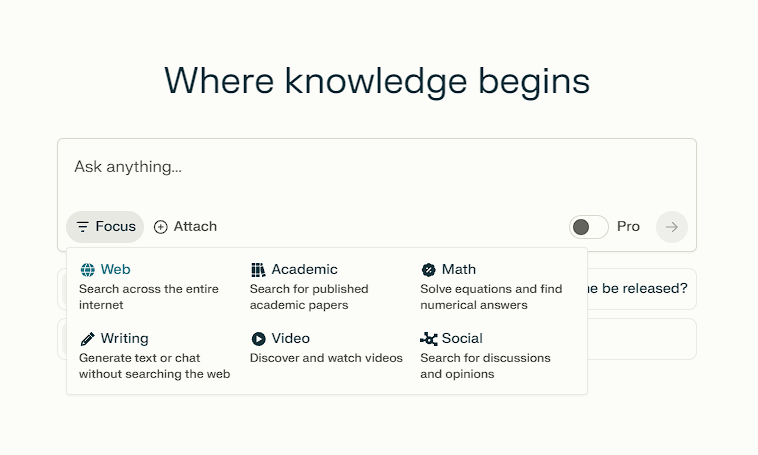Perplexity AI has emerged as a significant player in the realm of search engines and research tools, offering a unique blend of features that distinguish it from traditional platforms. Can it dethrone Google as our go-to search engine of choice? For me it already has, but I think it is going to need to go through a rebrand if it wants to. In the following article we will cover some of the reasons why I find myself using it more than Google or Bing. I also want to discuss why I think it is going to need to change its... read more
Perplexity could dethrone google
Perplexity AI has emerged as a significant player in the realm of search engines and research tools, offering a unique blend of features that distinguish it from traditional platforms. Can it dethrone Google as our go-to search engine of choice? For me it already has, but I think it is going to need to go through a rebrand if it wants to. In the following article we will cover some of the reasons why I find myself using it more than Google or Bing. I also want to discuss why I think it is going to need to change its name if it wants to compete for the top spot.
Innovative Search Capabilities
Conversational Interface
Perplexity AI utilizes a conversational approach, allowing users to interact with the tool in a natural language format. When people first started to use Google this is what they did—I’m sure some older relatives of yours still do this. “How can I fix the faucet so my wife will stop complaining about the dripping noise in the middle of the night” versus “dripping faucet fix youtube.”
As time went on people started to change how they “spoke” to their search engine, realizing that certain words (tokens) did not enhance the search results, while others did. Now we are going back to a more natural way of interfacing with the machines, and they in turn are doing the work to figure out what is important in this query and what is not. This design enables users to pose questions as they would in a discussion, making the search experience more intuitive compared to conventional search engines like Google. The ability to ask follow-up questions seamlessly enhances user engagement and facilitates deeper exploration of topics.
Organizational Features
The ability to organize queries into collections allows users to manage their research efficiently. This feature is particularly useful for individuals who conduct extensive research across multiple topics, enabling them to revisit previous inquiries easily.
Focus Search Feature
The Focus Search feature enables users to narrow down their queries to specific domains or platforms such as YouTube or academic databases. This capability helps prevent distractions from irrelevant content while ensuring that users find precisely what they are looking for. Such targeted searching is invaluable in today’s information-rich environment.
 The ability to change the focus is so helpful and you can attach documents to help you write or research.
The ability to change the focus is so helpful and you can attach documents to help you write or research.
Multi-Source Compilation
One of Perplexity’s standout features is its capability to aggregate information from multiple sources rapidly. By employing advanced natural language processing (NLP) techniques, Perplexity synthesizes data from various websites and databases, providing users with comprehensive answers rather than just a list of links. This multi-source approach not only saves time but also enriches the quality of information presented.
Reliability and Accuracy
When using AI for research, the whole point is to lessen the time it takes for you to work. Checking manually is very time consuming, but with features in Perplexity, this becomes a non-issue.
Fact-Checking Features
Unlike many generative AI tools that can produce hallucinated or inaccurate responses, Perplexity is designed with reliability in mind. It emphasizes factual outputs and provides citations for the information it presents, allowing users to verify sources easily. This feature is particularly beneficial for academic research and professional inquiries where accuracy is paramount.
User Feedback on Performance
Users have reported high satisfaction with Perplexity’s performance in academic contexts. Many have noted that it often delivers accurate results without the need for extensive cross-checking against other sources. This reliability positions Perplexity as a valuable assistant for researchers and students alike.
Branding and its role in dethroning Google
Right now there are millions of people that say “did you google it” in the same way people used to say “can you give me a kleenex.” The brand becomes the verb, even if you are using the competitor’s product! I remember asking someone on a project if they googled the error and they pulled up Bing and searched. That is powerful marketing, because googling is now synonymous with searching.
Right now I cannot picture anyone saying “did you perplexity it?” Personally I think this is Perplexity’s biggest hurdle.
Perplexity AI stands out as a powerful tool that combines innovative search capabilities with reliability and user-centric design. Its ability to provide accurate information backed by sources makes it an excellent choice for anyone seeking knowledge—be it students conducting academic research or professionals needing quick access to reliable data.
As it continues to evolve and expand its features, Perplexity AI is well-positioned to redefine how we approach online searches and information gathering. The conversational interface feels like the future of search, returning us to a more natural way of asking questions while leveraging AI to understand our intent better than ever before.
If you haven’t given this a chance, I highly recommend trying it out. The future of search might not be about learning to speak like a search engine—it might be about search engines learning to speak like us.

